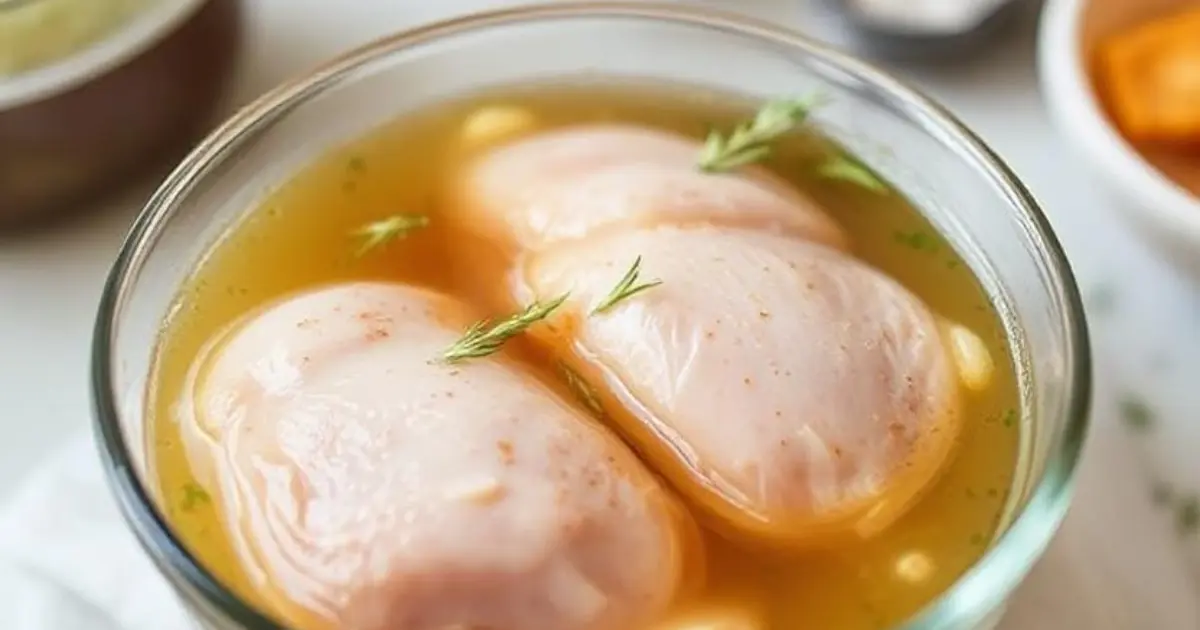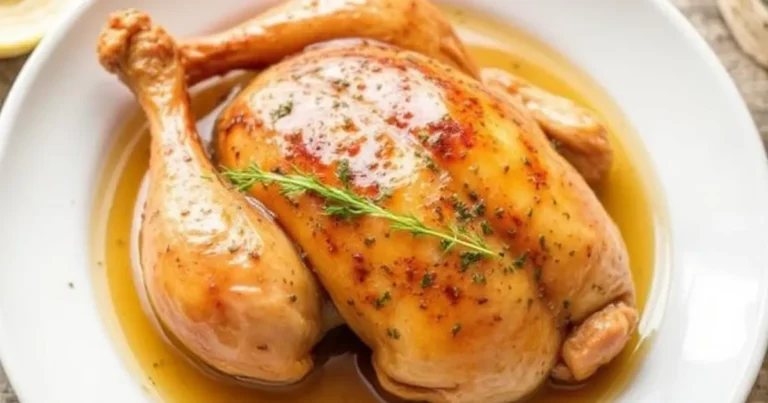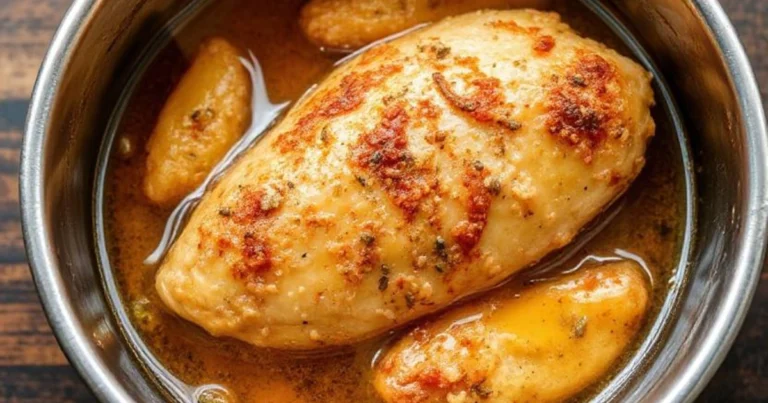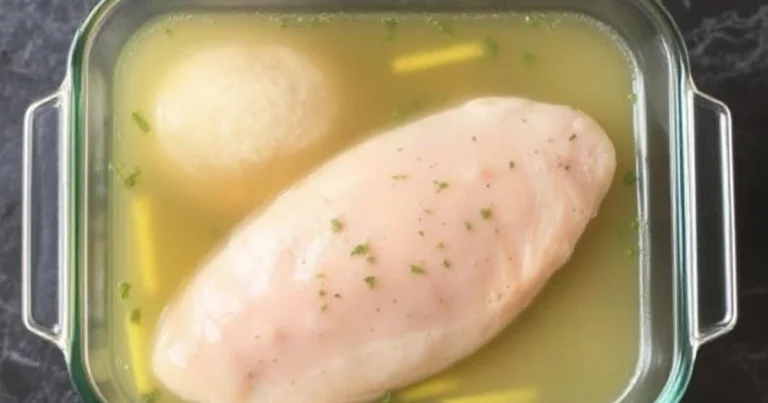Chicken Brine Guide
Discovering the perfect chicken brine can make your cooking amazing. Whether it’s a Sunday roast or a summer barbecue, a good brine makes the meat juicy and flavorful.
Chicken brine is more than salt water. It’s a cooking technique that makes your chicken taste like it’s from a restaurant. By learning the science of brining, you can make chicken that wows everyone.
This guide will teach you all about making the best chicken brine. You’ll learn basic and advanced techniques to make your chicken dishes better. You’ll see how simple brining can make a big difference.
Table of Contents
Understanding Chicken Brine Basics
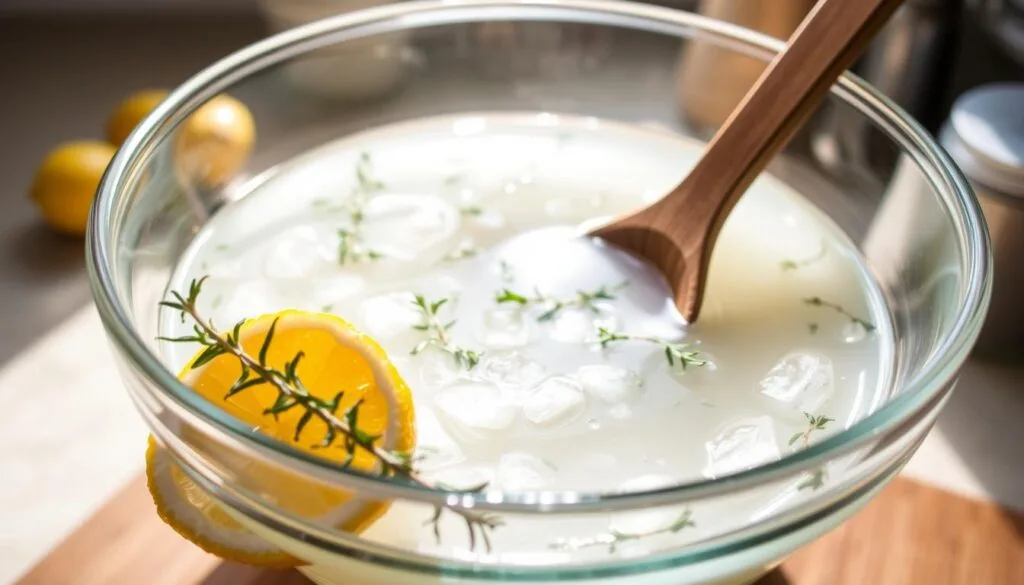
Exploring chicken brine can boost your cooking skills and make your dishes better. A chicken brine is not just salt water. It’s a method that makes your chicken taste and feel better.
What Makes Brine Different from Marinade
Marinades only cover the meat’s surface. But a brine goes deep into the meat. The main differences are:
- Deeper flavor penetration
- Better moisture keeping
- Changes in protein structure
The Science Behind Brining Process
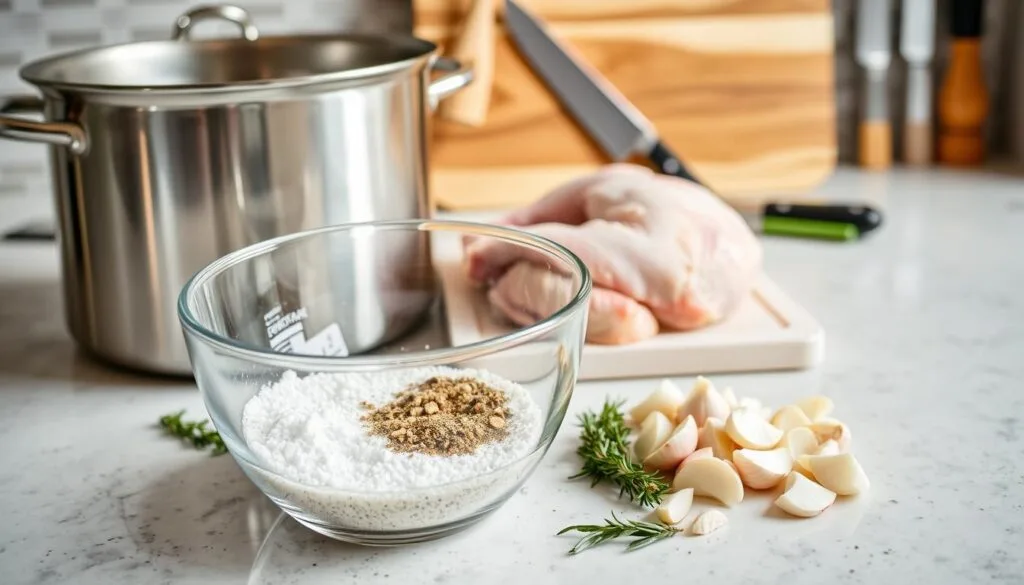
The brining magic comes from osmosis. When chicken is in saltwater, the salt breaks down proteins. This lets water get in, making the chicken incredibly juicy when cooked.
Benefits of Brining Your Chicken
Brining your chicken has many benefits:
- Keeps meat moist
- Makes flavors spread evenly
- Makes meat tender
- Reduces dry, tough chicken
Learning these basics will help you make perfect chicken every time.
Essential Ingredients for a Successful Chicken Brine

To make a perfect chicken brine, you need to know the key ingredients. These ingredients turn regular chicken into a juicy, tasty dish. Your brine recipe starts with a few basic parts that boost moisture and flavor.
The base of a great chicken brine is salt. Use kosher salt or sea salt for their clean taste and ability to get into the meat. Table salt can work, but it might add iodine flavors you don’t want.
- Water: The liquid base that helps distribute salt and other flavors
- Salt: Primary tenderizing and flavor-enhancing ingredient
- Sugar: Balances saltiness and helps create golden-brown exterior
But you can also add exciting things to your brine:
- Fresh herbs like rosemary and thyme
- Citrus zest for brightness
- Whole peppercorns
- Garlic cloves
- Bay leaves
Professional chefs say to try different ingredients to make unique flavors. Each part adds to the depth and complexity of your brine.
“The right brine can turn an average chicken into a culinary sensation.” – Professional Chef
But remember, balance is everything. Too much salt can make chicken tough, and too little won’t tenderize it well. You want a mix of flavors that brings out the chicken’s natural taste.
Perfect Brine Ratios and Measurements
Learning to brine chicken breast is all about precision and knowing the right techniques. This process turns regular chicken into a juicy, flavorful dish. It’s sure to wow your guests.
To get the brine just right, you need to pay attention to a few key things. Success comes from knowing the right amounts, timing, and temperature for each chicken cut.
Salt-to-Water Proportions
The first step in brining chicken breast is getting the salt ratio right. Here are some common guidelines:
- 4 cups water to 1/4 cup kosher salt
- 1 gallon water to 1 cup kosher salt
- Use a 5-6% salt solution for the best results
Timing Guidelines for Different Cuts
Brining time changes based on the chicken cut and size. Here’s a quick guide for your brining journey:
| Chicken Cut | Brining Time | Maximum Recommended Time |
|---|---|---|
| Chicken Breast | 30-60 minutes | 2 hours |
| Whole Chicken | 8-12 hours | 24 hours |
| Chicken Thighs | 1-2 hours | 4 hours |
Temperature Considerations
Always brine in the refrigerator to prevent bacterial growth. Keep your chicken at 34-40°F during brining. After brining, pat dry and let it rest at room temperature for 30 minutes. This helps with even cooking.
“The key to perfect brining is balance – too little time means no flavor, too much time results in overly salty meat.” – Professional Chef’s Recommendation
How to Brine Chicken Breast for Maximum Tenderness
Brining chicken breast is a game-changer. It turns regular chicken into a juicy, flavorful dish. Learning how to brine chicken breast right can prevent dry, tough meat that often happens to home cooks.
To brine chicken breast perfectly, start with the basics. Choose fresh, high-quality chicken breasts. Then, make a salt-water solution to keep moisture in. Your brine should have:
- Cold water
- Kosher salt
- Optional aromatics like garlic or herbs
For the best results, follow these steps:
- Make a basic brine with 5% salt
- Soak chicken breasts fully
- Keep them in the fridge during brining
- Brine for 2-3 hours max
Pro tip: Rinse your chicken after brining to get rid of extra salt. Then, dry them with paper towels before cooking. This makes the outside crispy and keeps the inside moist.
Temperature is key when brining chicken breast. Keep your brine and chicken at 34-40°F to avoid bacterial growth. A good fridge is essential for safe brining.
The magic of brining is its ability to help proteins retain water, resulting in incredibly tender chicken every single time.
Creating Flavorful Smoked Chicken Brine
To turn a regular chicken into a smoky treat, you need more than salt and water. A good smoked chicken brine adds deep flavors. It makes the meat tender and juicy, perfect for barbecue lovers.
Making the perfect smoked chicken brine is an art. It’s about finding the right mix of ingredients and techniques. Your brine is more than just seasoning; it prepares the chicken for smoking.
Smoking Wood Pairings for Exceptional Flavor
Choosing the right wood is key to a great smoked chicken brine. Each wood type gives a unique flavor that goes well with your brine:
- Apple wood: Provides a sweet, mild flavor
- Hickory: Offers a strong, bacon-like taste
- Cherry wood: Delivers a subtle fruity undertone
- Pecan: Creates a rich, nutty essence
Temperature Control Techniques
Keeping the temperature steady is important when smoking chicken. Your smoker should be between 225-250°F. This ensures even cooking and the best flavor.
| Chicken Cut | Recommended Smoking Temperature | Approximate Smoking Time |
|---|---|---|
| Whole Chicken | 240°F | 3-4 hours |
| Chicken Breasts | 225°F | 1-2 hours |
| Chicken Thighs | 250°F | 2-3 hours |
Recommended Smoking Times
The time you smoke your chicken affects its texture and taste. Always check the meat’s internal temperature with a thermometer. It should be 165°F for safety.
Pro tip: Let your brined chicken rest at room temperature for 30 minutes before smoking. This helps it cook evenly and absorb flavors better.
Fried Chicken Brine Secrets
Unlocking the perfect fried chicken starts with a game-changing fried chicken brine. This secret technique transforms ordinary chicken into a crispy, juicy masterpiece. It will have everyone asking for your recipe.
A successful fried chicken brine does more than just add flavor. It works magic by breaking down protein structures. This helps your chicken stay tender and moist during the intense frying process. The key is understanding how salt and liquid interact with chicken meat.
- Use kosher salt for the most effective brine solution
- Incorporate buttermilk for extra tenderness
- Add herbs and spices to enhance flavor penetration
Your fried chicken brine should typically include:
- Water or buttermilk base
- Kosher salt (about 1/4 cup per quart)
- Optional sugar for balanced flavor
- Selected spices like paprika, garlic powder, or cayenne
Pro tip: Brine chicken pieces for 4-12 hours before frying to achieve maximum flavor and juiciness. The longer you brine, the more tender and flavorful your chicken becomes.
The secret to restaurant-quality fried chicken lies in the brine, not just the breading.
Temperature matters when brining. Keep your chicken between 34-40°F to prevent bacterial growth. Always refrigerate during the brining process and pat the chicken dry before coating and frying.
Seasonal Brine Recipes and Variations
Changing with the seasons can make your brine chicken recipe better. Each season brings new flavors that can make your chicken special. Knowing what’s in season helps you make dishes that truly stand out.
Creating a great brine is all about being creative and knowing what tastes good together. Every season has its own set of ingredients that can add something special to your chicken.
Summer Citrus Brine
Summer is the time for light, refreshing flavors. A citrus brine can make your grilled chicken taste zesty and bright.
- Fresh lemon juice
- Orange zest
- Sea salt
- Cracked black pepper
- Fresh thyme
Winter Herb Blend
Winter calls for warm, herb-infused brines. These brines add depth and complexity to roasted chicken. They capture the cozy feel of winter cooking.
- Dried rosemary
- Sage leaves
- Garlic cloves
- Coarse kosher salt
- Bay leaves
Special Holiday Combinations
Holiday meals need something extra special. A well-made brine chicken recipe can be the star of your holiday feast.
| Holiday | Brine Ingredients | Recommended Cooking Method |
|---|---|---|
| Thanksgiving | Apple cider, sage, thyme | Roasted whole chicken |
| Christmas | Cranberry juice, orange peel, cinnamon | Herb-crusted roast |
| New Year’s | White wine, garlic, black pepper | Grilled spatchcock chicken |
Pro tip: Always adjust salt proportions and brining time based on your specific chicken cut to ensure perfect flavor and texture.
Common Brining Mistakes to Avoid
Getting your chicken brine right is key. Many home cooks face common errors that can ruin their dish. These mistakes can turn a great meal into a bad one.
Some common mistakes include:
- Over-salting your brine: Too much salt makes chicken salty and tough
- Choosing the wrong salt for chicken brine
- Brining for the wrong amount of time
- Ignoring food safety rules
The type of salt you use is very important. Kosher salt is best because it dissolves evenly. Table salt can make chicken too salty because it’s too dense.
How long you brine also matters. Different chicken parts need different brining times:
- Chicken breasts: 30-60 minutes
- Whole chickens: 8-12 hours
- Chicken thighs: 2-4 hours
Food safety is crucial when brining chicken. Always keep it cold and don’t reuse brine that’s been with raw meat.
Pro tip: Rinse your chicken well after brining to get rid of extra salt and avoid overseasoning.
Avoid these mistakes to make your chicken always tender and tasty.
Storage and Food Safety Guidelines
Proper storage and food safety are key when working with chicken brine. Keeping your food safe from bacteria makes sure your meal is tasty and safe for everyone. Knowing the safety rules helps you get better at making chicken brine.
Safe Temperature Zones
Keeping the right temperature is very important when handling chicken brine. Always keep your brined chicken at or below 40°F (4°C) to stop bacteria from growing. Use a reliable refrigerator thermometer to check temperatures often.
- Refrigerate chicken brine right after you make it
- Don’t let brined chicken sit at room temperature for more than 2 hours
- Use an instant-read thermometer to check the chicken’s internal temperature
Optimal Container Selection
Picking the right container for your chicken brine is very important for food safety. Choose containers that are non-reactive and made for food. They should not leach chemicals into your brine.
- Glass containers
- Food-grade plastic containers
- Stainless steel bowls
- Ceramic dishes with non-reactive glazing
Maximum Storage Guidelines
Knowing how long to store your brined chicken is key to avoiding foodborne illnesses. Raw brined chicken should be used within certain time frames to keep it safe and good quality.
- Refrigerator storage: 1-2 days maximum
- Freezer storage: Up to 2 months if sealed properly
- Label containers with the brining date
- Always check the chicken before cooking
By following these guidelines, you’ll make sure your chicken is delicious and tender. Plus, you’ll keep your health safe.
Conclusion
Brining chicken makes ordinary meals into something special. By learning the science and techniques of brining, you can add amazing flavor and tenderness to your dishes. Your cooking skills will grow as you try new ingredients and methods from this guide.
The secret to great chicken brine is being precise and creative. Whether you’re making a classic roasted chicken or trying gourmet smoking, the basics stay the same. Use top-notch ingredients, keep the salt ratio right, and watch your timing and temperature for the best results.
Your chicken brining adventure is just starting. Every recipe you try will improve your skills and taste. Start with simple methods and then move on to more complex flavors. Remember, the more you practice, the better you’ll get.
Chicken brine is very versatile. It works for summer grilling and winter roasting. Your dishes will always impress with their juicier, tastier chicken. It’s a great way to make your meals stand out.
FAQ
What is the purpose of brining chicken?
Brining chicken helps it stay moist and flavorful. The salt solution breaks down proteins. This lets the meat absorb more water and seasonings, making it juicier and tastier.
How long should I brine chicken breasts?
Brine chicken breasts for 30 minutes to 2 hours. Don’t brine for more than 2 hours to avoid too much salt. Thicker breasts might need a bit longer, but be careful not to over-brine.
What’s the basic ratio for a chicken brine?
Use 1/4 cup of kosher salt per quart of water for a basic brine. You can add sugar, herbs, and spices for extra flavor. If using table salt, use about 2 tablespoons per quart because it’s denser.
Can I use table salt instead of kosher salt for brining?
Yes, but use less table salt. It’s denser than kosher salt. Also, table salt has iodine and anti-caking agents that might change the flavor slightly.
Is it necessary to rinse chicken after brining?
Yes, rinse the chicken well after brining to remove excess salt. Dry it with paper towels to get a good sear or crisp skin when cooking.
Can I reuse brine?
No, never reuse brine that’s been with raw chicken. It can cause bacterial contamination and foodborne illness. Always make fresh brine for each batch of chicken.
What’s the difference between wet and dry brining?
Wet brining means soaking chicken in a saltwater solution. Dry brining involves rubbing salt and seasonings on the chicken’s surface. Both methods can improve moisture and flavor, but dry brining is easier and uses less space.
Can I brine frozen chicken?
It’s best to thaw chicken before brining. Brining frozen chicken can cause uneven salt absorption and safety issues. Always thaw chicken in the fridge before brining.
How does brining affect different cooking methods?
Brining works for grilling, roasting, smoking, and frying. It’s especially good for lean meats like chicken breasts that dry out quickly. Adjust brining time and technique for each cooking method.
Are there any alternatives to salt for brining?
While salt is key for brining, you can try alternatives like soy sauce, miso, or baking soda. But they won’t work exactly like salt. Salt is essential for breaking down proteins and keeping meat moist.

